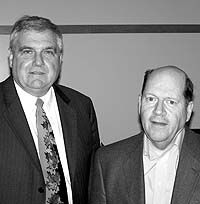| Utah Power president, Rich Walje and Ernest Wessman, vp of resource development and construction for Utah Power speak to county residents. |
Rich Walje, president of Utah Power, hosted an informational meeting at the Museum of the San Rafael recently. We have a huge impact in this part of Utah. When we start something, people jump to conclusions. We want to set things straight in this meeting, said Walje.
We met with many of our employees today, and we also met with the Emery County Commissioners, to try and update them on projects in the future. One thing that is definitely going to happen is that we are going to file a rate case. This translates into a request for a rate increase for customers. Our current rates do not support our level of investment.
We provide power to six states, Utah, Idaho, Wyoming, Oregon, California, and Washington. Over the last 10 years, we have invested an average of $90 million per year in substations, poles, and etc. This rate increase is needed to cover our investment, Walje continued.
Scottish Power has been a good owner and improved many parts of the company. One thing is that our customer service has improved. The sale to Mid-American is moving ahead and is nearly approved by all the involved parties. The final approval will probably come right away.
One difficulty we face is people want power, but they do not want the power generation facilities in their backyard. We are considering another power plant or additions to existing plants. Those ideas are still in the planning stages and nothing is definite at this time, Walje concluded.
Ernest Wessman, vice president of resource development and construction was next. Utah is one of the three or four fastest growing states in the nation. We need enough generating capacity to meet the needs during peak demands. We have not had to raise rates until now because we have found more efficient ways to do our work. We have made modest improvements in the past year in less frequent outages and duration of those outages. However, we are not advancing as fast as wed like.
The current rates which we charge do not support our level of investment. Pressure on rates is upward and our next rate case will be filed soon. We have set targets for improvement and we are working with Emery County officials toward those goals.
It is a monumental task to get a power plant on the ground. It takes years and billions of dollars. It also takes into account our obligation to serve our customers and their needs, and because we serve six states, all six of those states must agree on each project.
We have a 20 year plan and we review and renew that plan every two years. That plan was last updated in 2005. That plan selects the types and timing of new plants, but not a specific resource. In the plan, there is a planning margin that says we must be capable of delivering 15 percent over the demands at peak times. By 2011, our projected demand will be more than our supply capability.
We know our needs and must plan for them. In the 2012-2014 time frame, we will need more generating capabilities. By 2012, there will be a new power plant in either Utah, Idaho or Wyoming to meet our estimated demands. The decision has not yet been made as to where it will be located.
Our gas fired plant near Mona will be operational within the next two weeks, and the Lake Side plant will be coming online soon after that. Another aspect that we consider is the comparison of purchasing the power from other suppliers or to build our own generating plants. Consideration and approval is a lengthy process, so to meet the needs of 2012, a decision will be required and the process of approval must begin by mid 2006.
Studies are underway now which will determine the direction we will go. We are considering a Hunter 4 supercritical unit, a Hunter 4 IGCC unit, a Jim Bridger 5 supercritical unit, a Jim Bridger 5 IGCC unit, or unit 3 to IPP which would be a conventional pulverized coal unit.
Work is continuing on the environmental permitting and other studies that keep additional options available. The selection of the next resource is not imminent, said Wessman.
Following the presentation from Walje and Wessman, each took questions from the audience. During that time they said that Utah Power/PacifiCorp is exploring alternative energy producing sources, but at the moment coal is still the preferred source. The company is researching ways to reduce the environmental footprint of coal fired power plants.
When asked about the use of natural gas in gas fired power plants, Walje stated that the high volume of gas use that it takes to run a power plant can impact the price of natural gas to homeowners. The price should begin to come back down as natural gas production increases.
At the conclusion of the informational session, Walje informed the group that in six-eight months, the group will return for another update.

